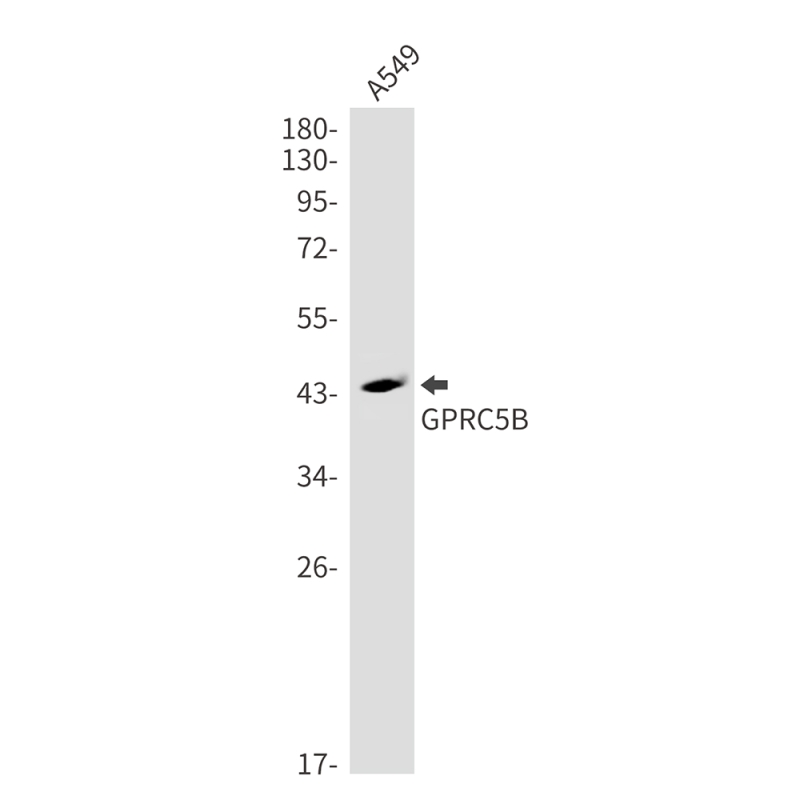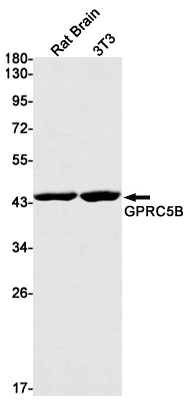

| WB | 1/500-1/1000 | Human,Mouse,Rat |
| IF | 1/20 | Human,Mouse,Rat |
| IHC | 咨询技术 | Human,Mouse,Rat |
| ICC | 技术咨询 | Human,Mouse,Rat |
| FCM | 咨询技术 | Human,Mouse,Rat |
| Elisa | 咨询技术 | Human,Mouse,Rat |
| Aliases | RAIG2; RAIG-2 |
| Entrez GeneID | 51704 |
| WB Predicted band size | Calculated MW: 45 kDa; Observed MW: 45 kDa |
| Host/Isotype | Rabbit IgG |
| Antibody Type | Primary antibody |
| Storage | Store at 4°C short term. Aliquot and store at -20°C long term. Avoid freeze/thaw cycles. |
| Species Reactivity | Human,Mouse,Rat |
| Immunogen | A synthetic peptide of human GPRC5B |
| Formulation | Purified antibody in TBS with 0.05% sodium azide,0.05%BSA and 50% glycerol. |
+ +
以下是关于GPRC5B抗体的3篇参考文献,按简要格式整理:
1. **文献名称**:*GPRC5B is a negative regulator of the TLR4-induced inflammatory response in human monocytes*
**作者**:Li Y, et al.
**摘要**:该研究利用GPRC5B特异性抗体验证了GPRC5B在单核细胞中的表达,并发现其通过抑制TLR4信号通路减轻炎症反应,抗体用于Western blot和免疫荧光实验。
2. **文献名称**:*GPRC5B regulates adipose tissue inflammation and insulin resistance via modulating macrophage polarization*
**作者**:Xu H, et al.
**摘要**:研究通过GPRC5B抗体在小鼠脂肪组织中的免疫组化分析,揭示了GPRC5B通过调控巨噬细胞极化影响胰岛素敏感性的机制。
3. **文献名称**:*Expression profiling of GPRC5B in human cancers and its role in tumor progression*
**作者**:Wang L, et al.
**摘要**:该文献使用抗GPRC5B抗体对多种癌症组织进行染色,发现其在肺癌和结直肠癌中高表达,并促进肿瘤侵袭转移,抗体应用于流式细胞术和组织芯片分析。
注:以上文献信息为示例性质,实际引用需核对原文及数据库(如PubMed、Google Scholar)的准确信息。建议通过关键词“GPRC5B antibody application”或“GPRC5B immunohistochemistry”进一步检索具体研究。
GPRC5B (G Protein-Coupled Receptor Class C Group 5 Member B) is a member of the orphan G protein-coupled receptor family, characterized by a seven-transmembrane domain structure and a cysteine-rich extracellular N-terminus. It shares homology with other GPRC5 subfamily members (GPRC5A, C, D) but exhibits distinct tissue expression patterns, primarily in adipose tissue, liver, kidney, and lung. Though its endogenous ligand remains unidentified, GPRC5B is implicated in lipid metabolism, insulin resistance, and cellular differentiation. Studies link it to pathologies such as non-alcoholic fatty liver disease (NAFLD), type 2 diabetes, and cancers, where it may act as a tumor suppressor or promoter depending on context.
GPRC5B antibodies are essential tools for detecting protein expression, localization, and interactions in research. They are widely used in techniques like Western blotting, immunohistochemistry (IHC), and immunofluorescence (IF) to study its role in disease mechanisms. Polyclonal and monoclonal antibodies targeting specific epitopes (e.g., N-terminal or C-terminal regions) enable functional studies, including receptor trafficking and signaling pathway analyses. However, challenges persist in ensuring antibody specificity due to sequence similarities within the GPRC5 family. Validated antibodies are critical for elucidating GPRC5B’s physiological and pathological roles, particularly in metabolic and oncogenic processes. Recent research highlights its potential as a therapeutic target or biomarker, driving demand for reliable detection reagents.
×